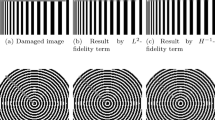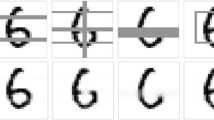Abstract
Image inpainting refers to restoring a damaged image with missing information. In recent years, there have been many developments on computational approaches to image inpainting problem [2, 4, 6, 9, 11–13, 27, 28]. While there are many effective algorithms available, there is still a lack of theoretical understanding on under what conditions these algorithms work well. In this paper, we take a step in this direction. We investigate an error bound for inpainting methods, by considering different image spaces such as smooth images, piecewise constant images and a particular kind of piecewise continuous images. Numerical results are presented to validate the theoretical error bounds.
Similar content being viewed by others
References
G. Aubert and P. Kornprobst, Mathematical Problems in image Processing: Partial Differential Equations and the Calculus of Variations, Vol. 147, of Applied Mathematical Sciences. Springer-Verlag, New York Inc, 2002.
C. Ballester, M. Bertalmio, V. Caselles, G. Sapiro, and J. Vergera, “Filling-in by joint interpolation of vector fields and gray levels,” IEEE Trans. Image Processing, Vol. 10, No. 8, pp. 1200–1211, 2001.
M. Bertalmio, A. Bertozzi, and G. Sapiro, “Navier-Stokes, fluid dynamics, and image and video inpainting,” in Proc. IEEE Computer Vision and Pattern Recognition(CVPR), Hawaii, 2001.
M. Bertalmio, G. Sapiro, V. Caselles, and C. Balleste, “Image inpainting,” in Proceedings of SIGGRAPH 2000, New Orleans, 2000.
M. Bertalmio, Luminita Vese, G. Sapiro, and S. Osher, “Simultaneous structure and texture image inpainting,” IEEE Trans. Image Processing, Vol. 12, No. 8, pp. 882–889, 2003.
V. Caselles, J.M. Morel, and C. Sbert, “An axiomatic approach to image interpolation,” IEEE Trans. Image Processing, Vol. 7, No. 3, pp. 376–386, 1998.
T. F. Chan and S. H. Kang, “Error analysis for image inpainting,” UCLA CAM 04-72, 2004.
T.F. Chan, S.H. Kang, and J. Shen, “Total variation denoising and enhancement of color images based on the CB and HSV color models,” Journal of Visual Comm. and Image Rep., Vol. 12, No. 4, pp. 422–435, 2001.
T.F. Chan, S.H. Kang, and J. Shen, “Euler’s elastica and curvature based inpainting,” SIAM Journal of Applied Math., Vol. 63, No. 2, pp. 564–592, 2002.
T.F. Chan, S. Osher, and J, Shen, “The digital TV filter and nonlinear denoising,” IEEE Trans. Image Process., Vol. 10, No. 2, pp. 231–241, 2001.
T.F. Chan and J. Shen, “Mathematical models for local deterministic inpaintings,” SIAM Journal of Applied Math., Vol. 62, No. 3, pp. 1019–1043, 2001.
T.F. Chan and J. Shen, “Morphology invariant PDE inpaintings,” Technical report, UCLA Dept. of Math, CAM 01-15, 2001.
T.F. Chan and J. Shen, “Non-Texture inpainting by curvature-driven diffusion (CDD),” Journal of Visual Comm. and Image Rep., Vol. 12, No. 4, pp. 436–449, 2001.
T.F. Chan and J. Shen, Image Processing and Analysis: Variational, PDE, wavelets, and stochastic methods. SIAM Publisher, Philadelphia, 2005.
T.F. Chan, J. Shen, and H. M. Zhou, “Total variation wavelet inpainting,” UCLA CAM report, 04-47, 2004.
T.F. Chan, L. Vese, and J. Shen, “Variational PDE models in image processing,” AMS Notice, Vol. 50, pp. 14–26, 2003.
L. Evans, Partial Differential Equations, American Mathematical Society, 1998.
L. Evans and R. Gariepy, Measure Theory and Fine Properties of Functions, Studies in Advanced Mathematics. CRC Press, Roca Baton, FL, 1992.
D. Gilbarg and N.S. Trudinger, Elliptic Partial Differential Equations of Second Order, Springer-Verlag, Berlin, 1977.
R. Gonzalez and P. Woods, Digital Image Processing, Addison-Wesley Publishing Company, 1992.
Y. Gousseau and J.-M. Morel, “Are natural images of bounded variation,” SIAM Journal of Mathematical Analysis, Vol. 33, No. 3, pp. 634–648, 2001.
A. Jain, Fundamentals of Digital Image Processing, Prentice Hall, 1989.
F. John, Partial Differential Equations, Vol. 1, of Applied Mathematical Sciences Springer-Verlag, New York Inc, 1981.
S.H. Kang, “Mathematical approaches to color denoising and image inpainting problems,” UCLA CAM 02–25, 2002.
S.H. Kang, T.F. Chan, and S. Soatto, “Inpainting from multiple view,” IEEE Proceedings of First International Symposium on 3D Data Processing Visualization Transmission, pp. 622–625, 2002.
S.H. Kang, T.F. Chan, and S. Soatto, “Landmark based inpainting from multiple view,” UCLA CAM, 02–11, 2002.
S. Masnou, “Variational formulation of the disocclusion problem,” The Abdus Salam, Int’l Centre for Theoretical Physics, School on Mathematical Problems in Image Processing, 2000.
S. Masnou and J.M. Morel, “Level lines based disocclusion,” in Proceedings of 5th IEEE Int’l Conf. on Image Process., Chicago, Vol. 3, pp. 259–263, 1998.
Author information
Authors and Affiliations
Corresponding author
Additional information
Tony F. Chan received the B.S. degree in engineering and the M.S. degree in aerospace engineering in 1973, from the California Institute of Technology, and the Ph.D. degree in computer science from Stanford University in 1978.
He is Professor of Mathematics and currently also Dean of the division of Physical science at University of California, Los Angeles, where he has been a Professor since 1986. His research interests include mathematical and computational methods in image processing, multigrid, domain decomposition algorithms, iterative methods, Krylov subspace methods, and parallel algorithms.
Sung Ha Kang received the Ph.D. degree in mathematics in 2002, from University of California, Los Angeles, and currently is Assistant Professor of Mathematics at University of Kentucky since 2002. Her research interests include mathematical and computational methods in image processing and computer vision.
Rights and permissions
About this article
Cite this article
Chan, T.F., Kang, S.H. Error Analysis for Image Inpainting. J Math Imaging Vis 26, 85–103 (2006). https://doi.org/10.1007/s10851-006-6865-7
Published:
Issue Date:
DOI: https://doi.org/10.1007/s10851-006-6865-7




